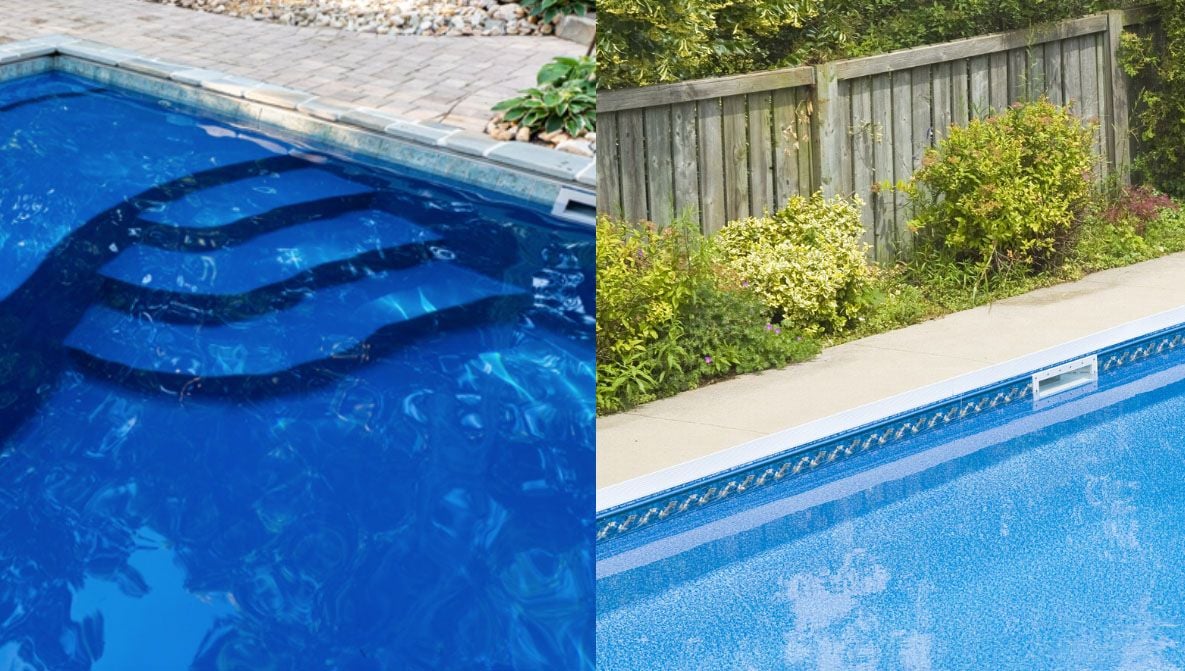
Topics:

In this video, you’ll see an existing vinyl liner pool that we converted to fiberglass. The most amazing aspect of this entire project is that the dilapidated vinyl pool you're about to see is only 15 years old…and it’s already gone through 3 liners!
For those of you debating whether vinyl or fiberglass is right for you, it can be difficult to overcome the appealing low initial cost of vinyl, but this video will demonstrate exactly why vinyl liner pools are not cheaper in the long run. In fact, the owner of the pool you're about to see had already invested well over $12,000 in liner replacements in only 15 short years. He decided to cut his losses and install a gorgeous fiberglass pool with relatively no long term cost of ownership.
But even if you remove the aspect of liner replacements from the equation, there are still significant differences between the look of fiberglass and vinyl liner pools, and this is the main focus of the following video.
You’ll see the differences between the look of a standard vinyl liner pool and a standard fiberglass pool.
Two of the major differences that we demonstrate in the video are:
Vinyl liner pools traditionally come with what’s called a “C” channel aluminum coping. This metal coping screws to the top of the wall panel and concrete is simply poured flush with the top. This makes for an easy concrete job, but the look is less than appealing.
In contrast, most fiberglass pool companies offer cantilevered concrete coping standard with their pool packages. You’ll see in the video how with cantilevered coping, the concrete actually creates the bull-nosed edge at the fiberglass pool. This is a much more difficult application, but as you’ll see it’s simply gorgeous as there’s no need for a white aluminum structure to retain the concrete. You can learn more about cantilevered concrete and how it’s formed and poured.
Standard vinyl liner pools come with white plastic steps that stand in stark contrast to the color and texture of the pool liner. Also, the steps are not integrated into the pool but protrude out from the pool wall making them even more conspicuous. “Buddy” seats can be added to vinyl liner pools, but the same challenges apply as they are made and installed in exactly the same fashion as the steps.
The steps and seats of fiberglass pools are integrated into the pool shell. This changes the entire look of the pool and allows for very user friendly seat and step configurations…and anyone who uses a pool on a regular basis knows that the majority of the time in the pool is spent lounging around on the steps and seats.
We discuss a few other differences in this short video, so take a minute and check it out. If you’re considering which type of pool might be best for you and your family, I promise it will be worth the time.
Please feel free to share any questions or comments below. Thanks and enjoy the video!
For a more in-depth comparison of all three inground pool types, be sure to download your free ebook below. You can also visit our educational video library or try out our free fiberglass pool pricing calculator today!
Up Next:
How Much Is My Fiberglass Pool Really Going to Cost?
Fiberglass vs. Vinyl Liner vs. Concrete Pools: An Honest Comparison
A Guide to Inground Swimming Pool Size, Costs, and Prices: Everything You Should Know
Jason Hughes is a partner at River Pools Virginia, a fiberglass pool installation company based in Warsaw, Virginia. With over 20 years of hands-on experience, Jason has dedicated his career to helping families create beautiful, functional backyards while ensuring every fiberglass pool installation meets the highest standards of quality and safety. In addition to his work with homeowners, Jason serves as a GENESIS instructor with the Pool & Hot Tub Alliance (PHTA), where he teaches fiberglass pool installation best practices to pool professionals across the country. Whether he’s on a job site or leading a training session, Jason is passionate about raising the bar for fiberglass pool installations and helping families make confident, informed decisions as they transform their outdoor spaces.
Topics:
River Pools® manufactures fiberglass pool shells and does not install pools. Pools are installed by locally owned and operated dealers and franchisees. The relationship between the dealers and franchisees to River Pools® is that of an independent contractor. River Pools Franchising LLC (Franchising) provides independently owned and operated River Pool franchisees with the right to market the River Pools brand of pool shells as a franchisee. Franchising does not manufacture pool shells. Due to the unprecedented and historic growth of the River Pools brand, this website contains an abundance of information that has been created over the last decade. Some of the content on this site may reflect prices, perspectives, processes, entities, and names that were relevant at the time but may not be as relevant today.
Consumers should consult their local installer (independent dealer or franchisee) for the most accurate and updated information based on the unique conditions of their property. Consumers should verify specifications with the installing dealer rather than relying on the information on this website, which is not intended to be a final specification.